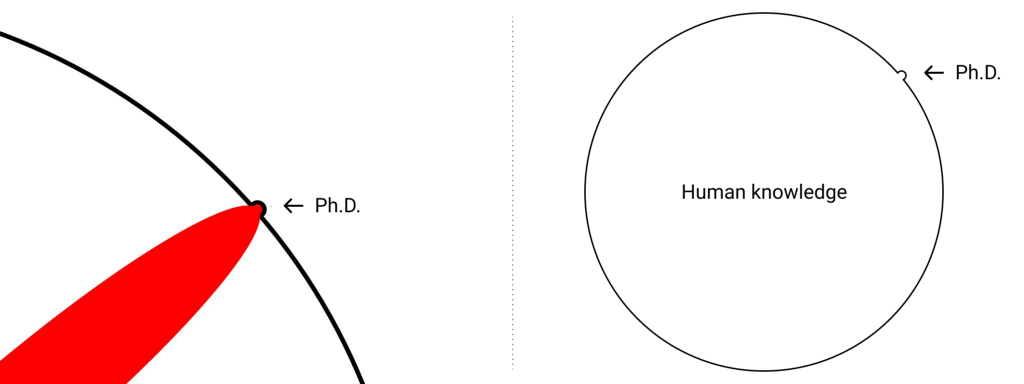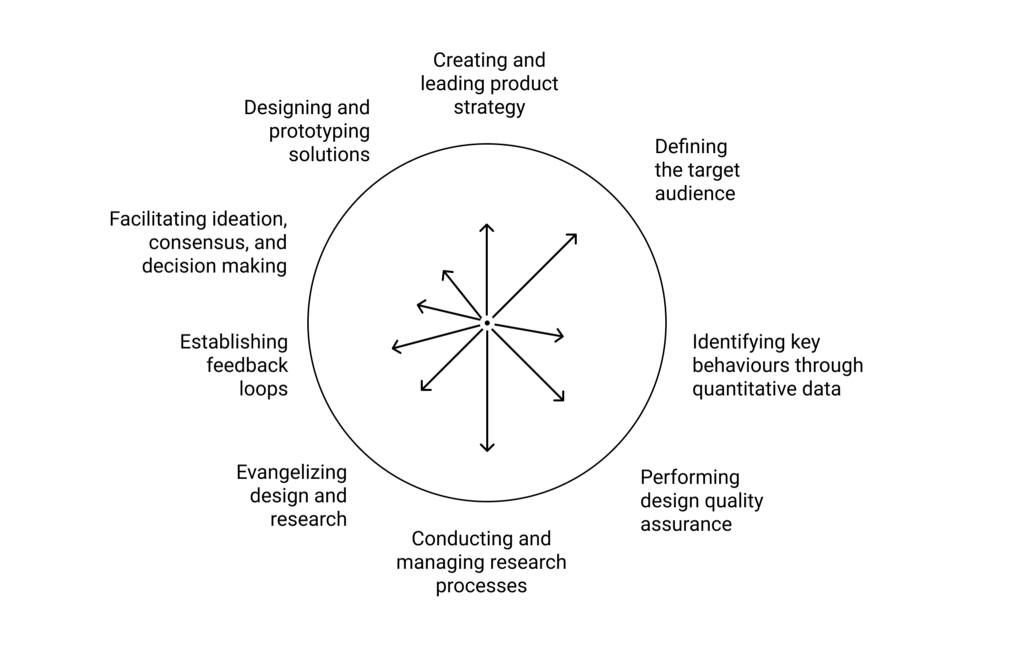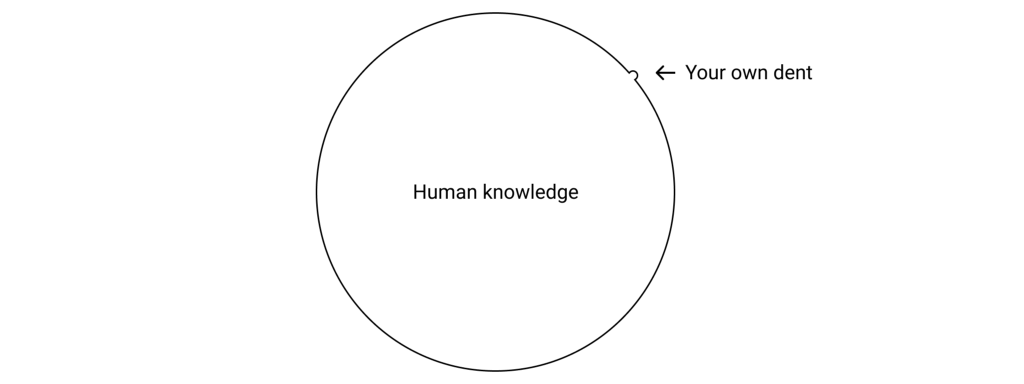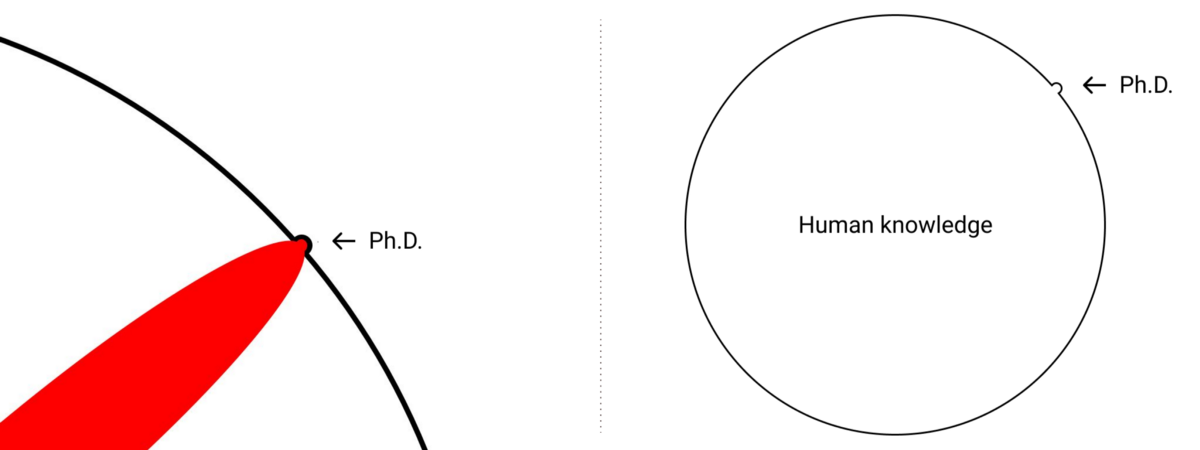Observed tensions in the user experience career progression
I’ve met user experience designers that are happy doing what they love with a strong sense of mission to change the world. I've also seen many of us going through an existential identity crisis with comparable intensity due to the vagueness of the profession.
Many of us aim at making a large, organizationally strategic impact. However, it hurts to realize the gap between what we want and what is possible. To alleviate that, we either try to bring reality closer to our expectations. Or we adapt our expectations to reality.
One of the most humbling depictions of an individual's contribution I've seen is Matt Might's illustrated guide to a Ph.D. Where the main point is that you spend years of hard work through elementary school, high school, working through a bachelor's degree, master's degree, reading research papers and finding your own focus, and eventually earn a Ph.D. when you actually make a small dent in the overall pool of human knowledge.

While it was originally intended for a fresh batch of Ph.D. students, it gives a sense of optimism that each of us can bring our own, unique dent in the overall pool of human knowledge through passion, perseverance, and work.
Sources of tension
Justifying a dedicated design competence
As designers, we are defined as ones who plan the look or workings of something prior to it being made, by preparing drawings or plans (Oxford Languages). However, this scope is so vague that it may hurt in real work settings. Planning and preparation are pervasive and done by everyone — project managers, product owners, business analysts, developers, and the list goes on. And presumably, this stage is also a place for wrestling for influence over the strategy and resources. Where in less healthy organization environments that result in unhealthy competition, the explosion of various job titles each claiming a bigger piece of power and mandate instead of focusing on actual contributions.
Nevertheless, user experience is a result, the responsibility of many. Rarely a formal mandate of a single specialty. User experience is as vague as innovation. Everyone innovates in their ways of working, be it a legal department, customer service, or design teams. The same goes for user experience, everyone defines it in their own context.
In such a case, does the user experience designer as a job title reflect the reality? Is it clear to business stakeholders what contributions are associated with such a role? Is there are a business case for design?
Just as there's no business case for the legal or accounting department, you will need a design competence by some name if you care how your products or services are experienced.
Pulling apart in too many directions
By using the above mentioned Matt Might's guide to Ph.D. as a metaphor, in the user experience field, we are often striving for making a dent in many different directions. Consequently, we lose focus and our limited resources for making a real impact within the organizations.

The symptom is an existential attempt to solidify the boundaries of user experience design and consequently a hard time explaining it to the stakeholders and other counterparts. Another symptom is the extent of spent resources on disputing the claims between overlapping competencies like user experience, customer experience, service design, and others that many articles are trying to settle like here, here, and here. And last, but not least — it's hard to set transparent and fair growth and compensation principles when professionals under the name of “user experience designers” have incomparable skillsets and responsibilities.
So one step forward would be being honest about what the individual design contributors are responsible for and what are their boundaries. Especially if the design field has scaled up and matured in the organization to the extent where it's possible to specify design roles. As for individual contributors, you may have something like this (in no particular order) –
- Industrial designer. Responsible for delivering tangible products that can be manufactured through mass production.
- Service designer. Responsible for planning and organizing resources to deliver effective services.
- Product / Interaction designer. Responsible for delivering a product design(typically digital) or a specific journey in the product.
- User interface designer. Responsible for delivering effective user interface design patterns that are consistent with the brand, best design practices, and technological platform considerations.
- Graphic designer. Responsible for delivering an effective message through visual content like images, typography, motion graphics, and illustrations.
- Organizational designer. Responsible for delivering effective workflow processes, procedures for the particular business.
In a senior or leadership role in small-scale organizations or in organizations with low design maturity level, the designers indeed may do a great part of everything, including delivering strategic recommendations, that may come in many different forms, including a business case for investing in initiatives that improve the user experience for the business benefit as well as leading through the implementation of the strategic recommendations.
Focusing on deliveries and not problem-solving
It is also not uncommon when tension appears between design professionals and their business partners due to conflicting expectations. Andy Budd puts this in terms of the gap between the design team’s expectations to be recognized for broader problem-solving capabilities and the organization’s expectations for the craft skills and ability to deliver. Where tension generally happens when, as Andy mentions, PM’s and Execs view Design and Tech teams as somebody to turn ideas into reality after the “strategic work” is done, ignoring the fact that building a product is much more involved than putting a deck together. Because delivering a strategy implies some change of direction, as Andy continues, which is hard and uncomfortable and maybe that’s why most companies have an execution problem.
In this case, it's up to designers to demonstrate that they can effectively contribute to making hard and responsible early-stage decisions with monetary consequences before producing anything at all. It means, embracing meetings, politics, and resource management.
Find a comfort zone
Progress is fundamentally important to human nature. And progress can only happen when built upon something stable, a comfort zone.
This year I’ve gained a revelation from the new leaders onboarding series at my organization. It may feel simple, even trivial for others, but for me, it made a significant impact. It revealed that just as it's important to go outside your comfort zone (that seems to have become like some sort of a mantra in move-fast, break-things startup culture), it’s even more important to find your comfort zone. The recommended ratio at the time was even 30:70 in favor of the comfort zone.
It made me think how valuable it is is to reevaluate periodically what's your comfort zone and where are the blind spots. There are countless progression models for engineers, designers, user researchers, and other professionals where mature design companies like Clearleft have well-articulated ways of assessing skill levels in the design industry. Others, like Spotify, are offering career models that are covering both experts and management career paths. Many talk about T-shaped or M-shaped professionals with strong expertise (comfort zone) in one or few areas and general understanding across multiple disciplines. The design team at Figma has found a way that works for them in terms of finding unique expertise in team members through evaluating craft skills and culture-fit. There is also a lot of thinking done and written by Jason Mesut in the Shaping Design series.
However, the hardest part is to be objective about one's own or other's evaluation. Among much good advice on how to avoid interrupt bias in teams, Joan C. Williams and Sky Mihaylo recommend checkpoints for ensuring objective evaluation criteria e.g. clarifying criteria; specifically focusing on demonstrated performance, not potential or personality; and having clear principles for training, promotion, and pay decisions based on the evaluation.
Sometimes, to make progress it means that you need to pair up with somebody that you complement each other and push together. As advocated by Figma (driver + navigator), Cooper (generator + synthesizer), and others.
However, achieving objectivity takes a lot of work. And perhaps it's as in Dwight Eisenhower's saying — “Plans are nothing. Planning is everything.”. And the same with performance evaluation — it's an ongoing process where an open and honest conversation is what matters the most.
Make a dent
John Maxwell has made a point that “passion without commitment is a heart without backbone and commitment without passion is focus without fuel.”
I wish you commitment to your chosen focus, passion to fuel your way towards making your own, unique dent in your organization’s and humanity’s knowledge pool, and perseverance, to keeping pushing the boundaries forward in whatever you do despite the difficulty in the upcoming year.

And as for designers and anyone with a user experience mindset, keep putting this mindset in the center, find ways to increase visibility and frequency of incoming feedback, and work together to identify opportunities and implement effective solutions.
Good luck in your endeavors 🚀 ✨

Observed tensions in the user experience design field progression was originally published in UX Collective on Medium, where people are continuing the conversation by highlighting and responding to this story.
